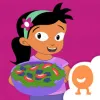Take a look inside 9 images
Nico & Nor Wonder Farm
Pros: The app is age-appropriate, and the lessons the developers provide are excellent.
Cons: No seed-to-seed connection is made.
Bottom Line: There's little doubt that this app will help students understand the basics of plant growth, especially if the included lessons are used.
Preschool, kindergarten, and first grade teachers can use Nico & Nor Wonder Farm as part of a unit where they need to explain what plants need to grow. The developers provide unit plans that are accessible on their website or through a separate iOS app. The Wonder Farm app plays an appropriate role in this sequence; it's a digital simulation that can help students understand and apply concepts that they're learning in the real world. Students won't need to wait for weeks or months to see plant growth like they might with real plants. Students can play with different variables and explore different combinations of variables that affect plant growth.
The included lessons begin by having teachers use student volunteers to model using the app. There's an emphasis on good science questioning, such as "What might a rabbit do to a carrot plant?" or "Why didn't our plant grow very much? What might help it grow better?" Students can then use the app in pairs or individually to explore different combinations of sunlight and water. Different types of plants have additional variables, such as earthworms, caterpillars, and rabbits. When a student kills a plant with too much water, sun, or rabbits, take the opportunity to ask why it happened and how the student can grow a healthier plant. Of course, teachers could find value integrating Wonder Farm into their existing curriculum as-is.
Nico & Nor Wonder Farm is an iOS app designed to teach young learners about plant growth. Characters guide or sometimes model how to use the app, and buttons that need to be pressed will pulse so that students know to touch them. Students begin by tapping a seed packet to plant a seed. Six circles will appear on the bottom of the screen, and at the top of the screen, circular icons of a watering can, sunlight, and (depending on the plant) an additional factor such as a worm. Students must drag the circular icons down to the six circles, attempting to create the right balance to get their digital plants to grow. At the end of the sequence, Nor will measure the plant. Students can try to grow the largest plant possible, though this isn't explicitly stated. Should students do something like overwater their plant, the character will suggest trying more sun and less water. There's also an activity where students drag different kinds of plants to a salad bowl to eat.
The developers provide unit plans, accessible on their website or a separate iOS app, that contain familiar activities such as planting a seed in a bag and reading plant-related books. There's also a companion app for students to make daily observations of plants and record growth through photos and measurements.
Nico & Nor Wonder Farm is an excellent addition to a curriculum for young learners. The app is developmentally appropriate with simple touchscreen controls and is easy to navigate. The lessons are appropriate for this age as well, spanning between 5 and 15 minutes in length. The app provides quality guidance and feedback for when students are working independently, helping students feel successful while the teacher is busy elsewhere. Just by using it, students would almost certainly understand what plants need to grow. Used with the included lessons, it can help drive home concepts that students are learning about in their real-world experiments. The app doesn't contain any gimmicks or pointless rewards. Students will feel rewarded when they figure out how to grow a healthy plant!
Nico & Nor Wonder Farm doesn't progress in difficulty. The most straightforward plant to grow is presented first, as students can only water it and give it sunlight. However, students can choose any plant at any time. Wonder Farm doesn't make a seed-to-seed connection, so it won't be as helpful for teachers who want to teach life cycles. Something like tapping a seed from a successfully grown plant to save for next time might avoid the misconception that seeds begin existence in a packet. Including additional languages would be a welcome improvement, too.



















